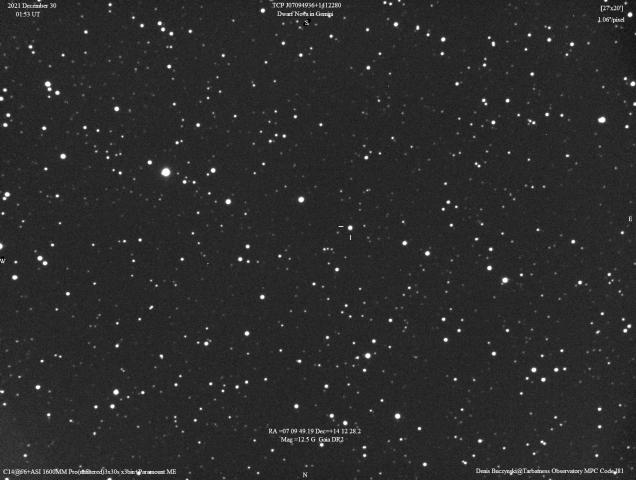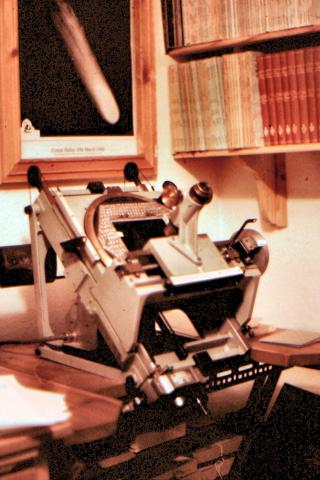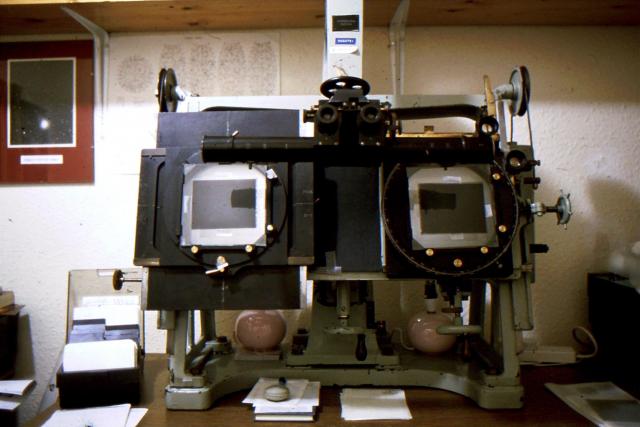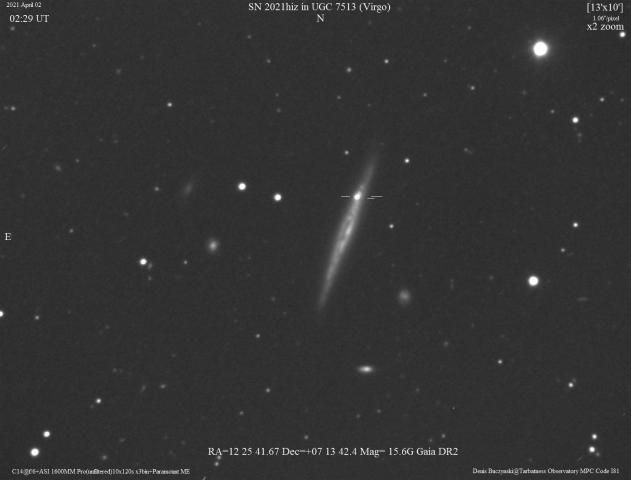Forum Replies Created
-
AuthorPosts
-
 Denis BuczynskiParticipant
Denis BuczynskiParticipantDon’t thow it away just offer it for sale to members, highest bid wins. Even as a curiosity it worth more than putting it in the bin.
 Denis BuczynskiParticipant
Denis BuczynskiParticipantRichard McKim has also suggested that we publish an obituary in the JBAA. I have spoken with Rob’s wife today and she is hopeful that an obituary of Rob will appear in a future JBAA. I am willing to write this.
Denis
 Denis BuczynskiParticipant
Denis BuczynskiParticipantHi David, I do not know who wrote that article. I see from the end postscript that he/she had a private communication with Glyn who must have given him details after the removal of the Mond Astrograph from NLO. I will ask Glyn’s wife, Christine, if she knows who wrote it. I remember that there was a book about the history of Sir Robert Mond amongst the material I sent down to NLO with the Mond Astrograph and the measuring machines and some documents that Glyn had assembled. Did you manage to compare the 7 inch Zeiss lens that Gyln had on the Mond Astrograph and the mystery 7 inch you found? Was the focal length of the mystery 7 inch determined?
 Denis BuczynskiParticipant
Denis BuczynskiParticipantIt would be worthwhile measuring the focal length , the original Mond Zeiss 7 inch was f/7. Also have a look at the 7 inch Zeiss triplet lens that we sent back to NLO (the one Harold Ridley passed on to Glyn) and see if they are similar.
 Denis BuczynskiParticipant
Denis BuczynskiParticipantThe main fact to find out is whether the optical design of the 7 inch you have found is a Petzval doublet or a Zeiss triplet(telephoto) . The original Zeiss triplet on the Mond was a triplet of f/7. Cooke mounted the Zeiss lenses onto the Mond astrograph for Robert Mond.I would look for some markings on the lens cell/housing which may show it to be a Zeiss.
Denis
 Denis BuczynskiParticipant
Denis BuczynskiParticipantWrite to The Antique Telescope Forum, there ar lots of experts involved in that group who will be able to give you the information you need.
 Denis BuczynskiParticipant
Denis BuczynskiParticipantHi David,
The large lens (7 inch) may well be the original 7 inch f/7 Zeiss astrograph lens that was missing from the Mond when Glyn Marsh and I rescued the instrument from NLO. The 7 inch lens was missing and was not amongst the other astrographic lenses we collected and are now back at NLO with the Cooke/Mond Astrographis mount. The 7 inch that you now have was one that Harold Ridley passed on to Glyn and did not come originally from the NLO.The lens design of the lens you ahve just found may be that of Petzval Doublet. The small 3 inch refractor looks like a guide telescope with a sliding plate that carries the eyepeice and diagaonal across the FOV to allow the observer to selected a guide star. I would guess that both instrument s were part of the original Mond Astrograph or from another of the large telescopes there at NLO. I have taken the liberty of posting your message and images on the Antique Telescope Forum to see if anyone ther can more positivley identify these instruments. Denis Buczynski
13 January 2022 at 1:04 am in reply to: 2022 Jan 21 – (212) Medea – a long-duration asteroidal occultation #585108 Denis BuczynskiParticipant
Denis BuczynskiParticipantHi Alex,
Is the shadow track well established. I see that I will be outside the track at Tarbatness. Is it still worth while me observing this event?
Denis
 Denis BuczynskiParticipant
Denis BuczynskiParticipantTarbatness observing statistics 2021 observations on nights when ccd comet astrometry and photometry was undertaken; Jan 19, Feb16,Mar12,Apr10,May4,Aug7,Sept10,Oct12,Nov9,Dec17. Total=116 nights This excludes any nights from mid May until mid August when observing is not possible at this lattitude 58d N due to all night twilight. Observations of other objects Novae, Supernovae, and other transients were made on nights when CCD comet imaging was taking place.Some deep sky ojects were imaged in colour. In the winter skies displays of Aurora were recorded. In the Summer skies displays of NLC were recorded. Meteor count on two cameras 12mm camera 2328, 3.8mmcamera 1844 Cameras are turned off from mid May to mid August due to all night twilight. All in all it was decentish observing year here at Tarbatness, I am not sure I could have done more.
 Denis BuczynskiParticipant
Denis BuczynskiParticipantImage of this object taken 20211230 0153 at Tarbatness. Image is south up and west left


 Denis BuczynskiParticipant
Denis BuczynskiParticipantYou may want to watch the talk I gave at the BAA Comet section meeting about comet magnitudes which mentions “the Sidgwick method. Here is the youtube link;
https://www.youtube.com/watch?v=S8I3TdaUjxY&list=PLzBTybazXT40groFEC3zg4uVLFFGdApQL&index=4
 Denis BuczynskiParticipant
Denis BuczynskiParticipantHello David.
This sounds like a very intersting project/programme for someone. I hope the Zeiss Blink Comparator and the Hilger Plate measuring machine that I gave to NLO a couple of years ago (part of the return of the Mond Astrograph after Glyn Marsh’s untimely passing) will be of use in this project.


 Denis BuczynskiParticipant
Denis BuczynskiParticipantHi Jeremy Looking at the Catalogue of Meteorites by G.T.Prior and Max Hay 1953 (Harold Ridley book) I see that the Gibeon Meteorite fell in SW Africa at Great Namaqualand and the finds are well documented in this book pages 131 and 132. Many large and small masses were found over wide area and 51 large masses over 15 tons have been recovered. These specimens have found between 1838 and 1910. So it is likely that the specimen you saw at Tatton Park could well be one of those.It was classified as Iron fine octahedrite. A 1.5 lb piece was sold at Christies in February 2021 for 12.500 dollars, So the 325 lb specimen at Tatton must worth a few quid! Christies gives this description :
Details
Like most iron meteorites, Gibeon meteorites formed 4.5 billion years ago within the molten core of an asteroid whose shattered remains are part of the asteroid belt. After wandering through interplanetary space, several thousand years ago the Gibeon mass slammed into Earth’s atmosphere where it exploded and rained down over what is now the Kalahari Desert in Namibia. In previous generations, indigenous tribesmen recovered small meteorite fragments at or near the surface and fashioned them into spear points and other tools. This specimen was recovered with the aid of a metal detector. Gibeon meteorites were not known to westerners until 1836. They formed deep in the iron core of an asteroid that resided between Mars and Jupiter. Denis BuczynskiParticipant
Denis BuczynskiParticipantHi Richard, I am sure that this Mike Peel is not the Mike Peel you are referrring to. I knew Mike Peel well, he was the Science librarian at the University of Central Lancashire and a variable star observer who made photoelectric measures with an IP21 photometer (you will remember those devices I expect!) with his home built 8 inch reflector. His main interest was in T Cor Bor using period analysis to try and to find when its outbursts would occur. He is much older than the astronomer in the link in Jeremy’s post, he will be in his 70’s I expect now.I hope this helps and brings to mind a past member who was very active within the VSS in the 1970-80s.
 Denis BuczynskiParticipant
Denis BuczynskiParticipantSome views throughout here at Tarbatness both NE and 102mm Mak+solar film. Cloud was thick at times but more attenuated after maximum eclipse. Clear, sunny and warm now! Liz watched the event NE via reflection from the glass coffee table with the sun behind thin cloud.So simple, looking down rather than up and without neck strain.
Denis Buczynski (Tarbatness still in the UK!)
 Denis BuczynskiParticipant
Denis BuczynskiParticipantI knew Sally when she lived in Windermere Cumbria. She was a keen visual lunar and planetary observer. A very fine person and so likeable. I helped set up the Elliot Merlin 12 inch reflector ( on loan from the BAA) at her home in Windermere in the 1990’s. She used it regularly and contributed many observations to the BAA observing sections. Picture of the Elloit Merlin telescope is attached. Unfortunately this fine example of a Calver refector so kindly bequethed to the BAA is now no longer usable having passed through the “care” of the last BAA Instrument Curator after it was returned to the BAA after Sally had finished using it. Picture of the telescope last time it was seen is attached.
 Denis BuczynskiParticipant
Denis BuczynskiParticipantThis amplified image shows the SN more clearly.
Denis
 Denis BuczynskiParticipant
Denis BuczynskiParticipantThis amplifield view shows the Sn more clearly.
Denis

 Denis BuczynskiParticipant
Denis BuczynskiParticipant
 Denis BuczynskiParticipant
Denis BuczynskiParticipantHere is my image of this object from last night 20210402 00:29 UT with astrometry of what I assume to be the SN.There are lots of knots in the galaxy arm and i have to use a small 3 pixel radius aperture to get a measurement.
Denis Buczynski I81
-
AuthorPosts
